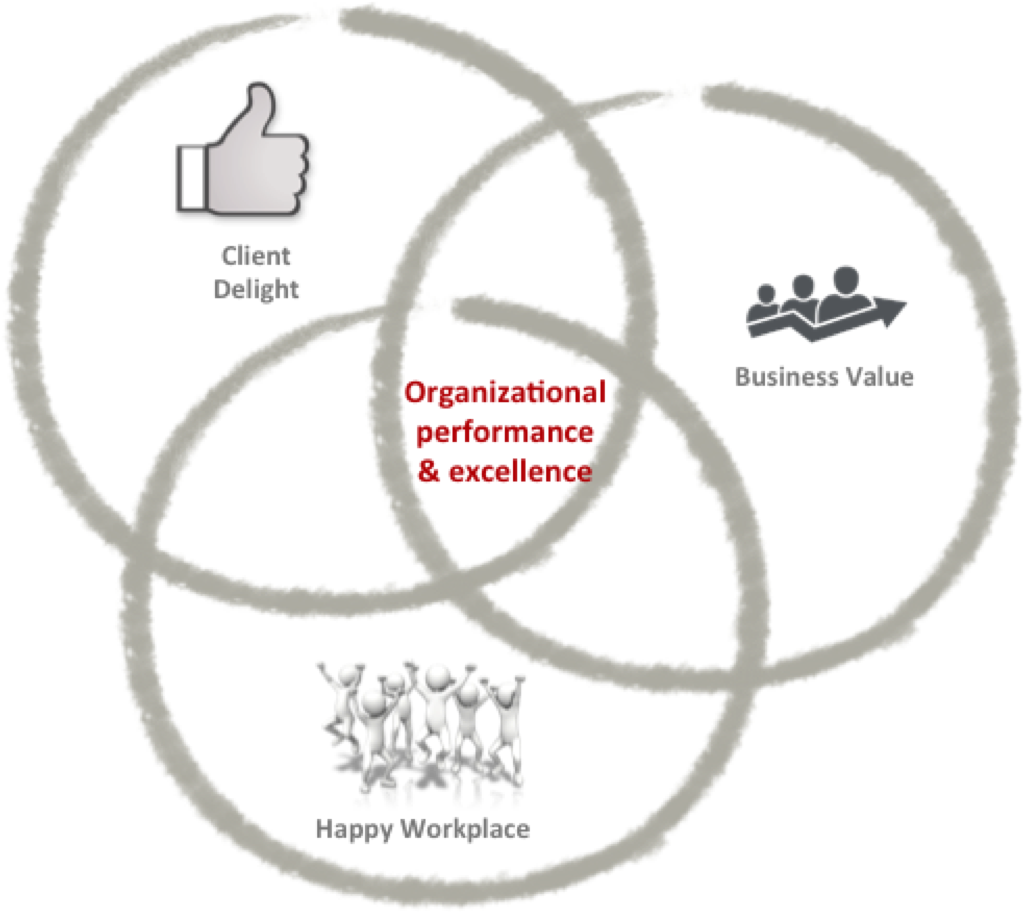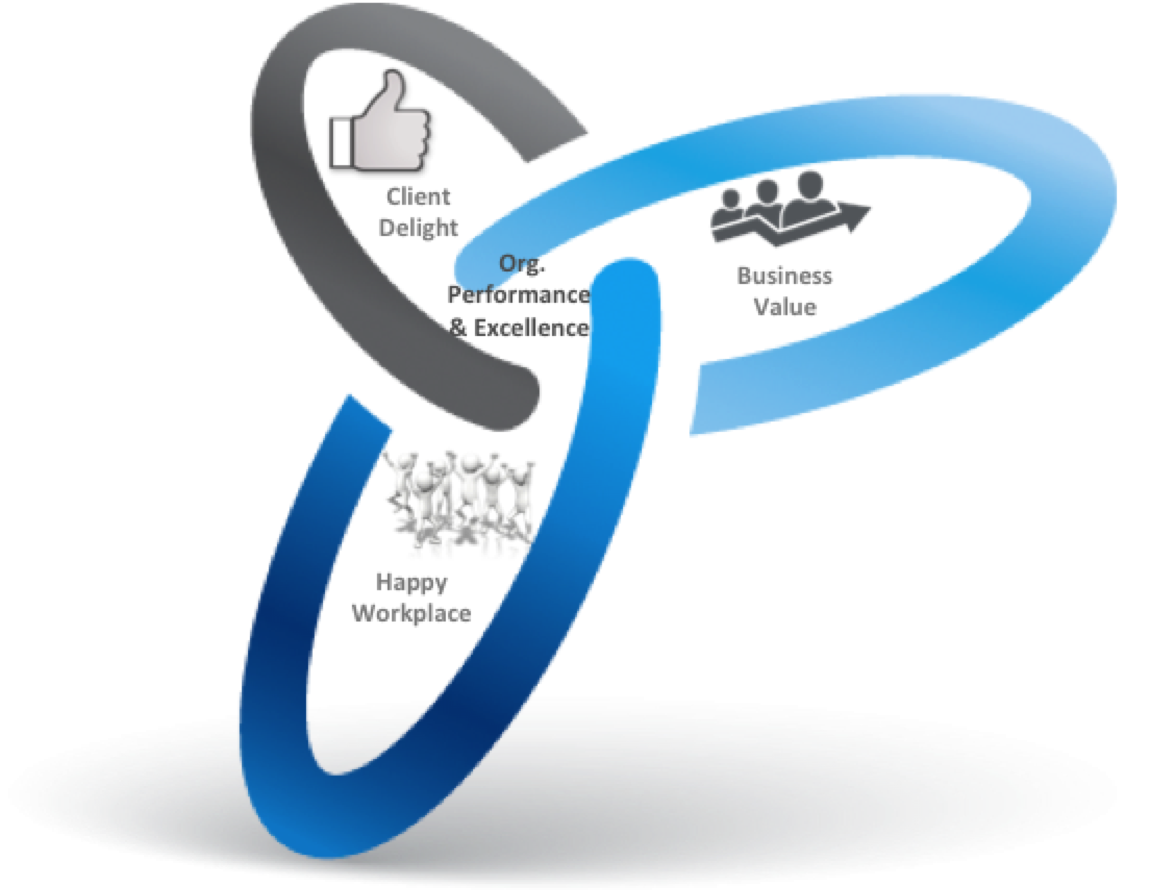The Heart of Organizational Excellence
In times of increasing competition in the marketplace, organizational excellence or performance is ever more important. But what does ‘organizational excellence or performance’ actually entail? What does it mean? And how can it be achieved? And, even more important, why does it matter?
I believe that there are three drivers for and to organizational excellence and performance. (1) delighting your clients, (2) building a happy workplace, and (3) sustaining business value. Let’s have a look at each one of these drivers to get a better understanding of what’s behind them.
The three drivers of organizational excellence
(1) Client delight
 Say, you have been staying at a hotel. The hotel was decent, your room was clean and spacious, breakfast was good and they even served some fresh fruits. On a scale from 1 = bad to 10 = excellent you may give this a hotel a 5 or 6 rating. You were satisfied. But you were not fascinated or delighted in a way that you would recommend this hotel to your peers, closest friends or family members.
Say, you have been staying at a hotel. The hotel was decent, your room was clean and spacious, breakfast was good and they even served some fresh fruits. On a scale from 1 = bad to 10 = excellent you may give this a hotel a 5 or 6 rating. You were satisfied. But you were not fascinated or delighted in a way that you would recommend this hotel to your peers, closest friends or family members.
The next time you visit the same city you are staying in a different hotel. This time it is a completely different story. The check-in runs smoothly, everything has been prepared for you, the room is just as clean as it was in the other hotel. But there is something special about this hotel. It could be the location, the architecture, the furniture, the people working there and serving you. No doubt, you are willing to return to this hotel. And even more so, you will probably recommend this hotel to your peers, closest friends and family members.
In the first example you were a satisfied customer. In the second example you were delighted. Which hotel do you think will have a better business outlook?
When running a business you have a choice. You can do the bare minimum to satisfy your customers or you decide to go the extra mile and delight your customers. In either case the prerequisite is that you know who your customers are. As self-explanatory as this is, there are a lot of companies that seem to have forgotten whom they really serve.
Another question every business should be able to answer is whether or not it wants to build customers for life or only for the short-term. What is more important quick, short-term profits or a long and outstanding customer relationship with long-term, sustainable profits which may yield less quick wins but greater pay offs in the long run?
And what about the customer’s perspective? Which company do you want to do business with. One which treats you like a number, a resource or a sole revenue source. Or a company that reaches out to you, seeks to understand and satisfy your needs, communicates with you, walks in your shoes and shows a sincere interest in you? – Client delight is about the second company.
(2) A happy workplace
 Most companies speak of their employees as assets. This sounds good and wonderful. But then, ‘assets’ for what? Are the employees just resources that add up to a bigger picture, the companies outcome, products and services? Unfortunately, most average companies fall into this category. This is not to say that treating people as human resources or human machines is advisory. Especially not if you are interested in organizational excellence and performance. Yes, you can train and treat them like machines, push them to their limits, get the most out of them – for some time, until they are either burnt out or leave your company. You replace them and start the process anew. You may be interested and actually achieve employee satisfaction. However, this is not to be mistaken with inspired, motivated and performing employees who enjoy their work because they can identify with the purpose of the company, love working with their colleagues and serving their customers, are passionate about their work and enjoy a safe, secure workplace.
Most companies speak of their employees as assets. This sounds good and wonderful. But then, ‘assets’ for what? Are the employees just resources that add up to a bigger picture, the companies outcome, products and services? Unfortunately, most average companies fall into this category. This is not to say that treating people as human resources or human machines is advisory. Especially not if you are interested in organizational excellence and performance. Yes, you can train and treat them like machines, push them to their limits, get the most out of them – for some time, until they are either burnt out or leave your company. You replace them and start the process anew. You may be interested and actually achieve employee satisfaction. However, this is not to be mistaken with inspired, motivated and performing employees who enjoy their work because they can identify with the purpose of the company, love working with their colleagues and serving their customers, are passionate about their work and enjoy a safe, secure workplace.
Companies can build such a workplace. Just as knowing the needs of their clients they have to show a sincere interest in the needs of their employees. It starts with a safe, secure and environmentally friendly work environment. For employees to follow a direction you have to set it, share it and let your employees contribute to it. Let them become a part of it.
A happy workplace does not mean that you have to do everything just to please your employees without expecting anything in return. Of course not. But you have to provide or at least build an environment where they can prosper and perform at their best. A first start is that you don’t treat employees as resources but as people, as human beings.
(3) Business value
 The former CEO of General Electrics, Jack Welch, describes the call for maximizing shareholder value as the dumbest idea in the world. Other describe it as corporate cocaine. In either way, the bottom line is that shareholder value is not identical to business value.
The former CEO of General Electrics, Jack Welch, describes the call for maximizing shareholder value as the dumbest idea in the world. Other describe it as corporate cocaine. In either way, the bottom line is that shareholder value is not identical to business value.
Think about the following: you want to invest into a company, or even better, you want to acquire a company. What do you look at? Just the present stock price and its outlook? Of course not. You take a number of factors into account: the overall business performance and outlook, customer satisfaction ratings, market position, innovation performance, the skillset and turnover rate of the workforce, the attractiveness of the company as an employer of choice and many other factors. But how come most companies these days just talk about satisfying shareholder interests and maximizing shareholder value?! Shareholder value is the result of a well-run business and not the other way around. Hence, treating shareholder value as the purpose and driver of your business is not smart but myopic and can even be detrimental to the value of your business. From a business perspective, it is plain stupid.
The sweet spot of organizational excellence
The sweet spot of organizational excellence is where all three drivers outlined above come together. If you depict the three drivers as three circles, it is the area where all three drivers overlap that you can spark organizational performance and excellence.

This is not a one-time effort. You have to continuously improve your own performance to stay in this sweet spot. In this sense, continuous self-improvement can be considered a fourth driver of and for organizational excellence. It adds a dynamic dimension to organizational excellence. Rather than a static Venn diagram with three circles we can depict this as a Möbius circle.

The bigger the overlapping areas of all three drivers, the better organizational performance is. This implies that in order to develop organizational performance you have to take all four drivers into account. This holistic view requires leadership, a specific mindset, philosophy and practice. It is not solely driven by short-term gains but balances long-, mid- and short-term needs and goals. It is has a clear customer and people focus and nurtures an open innovative culture.
It is this leadership which I will write about in my next blog post. Stay tuned.
